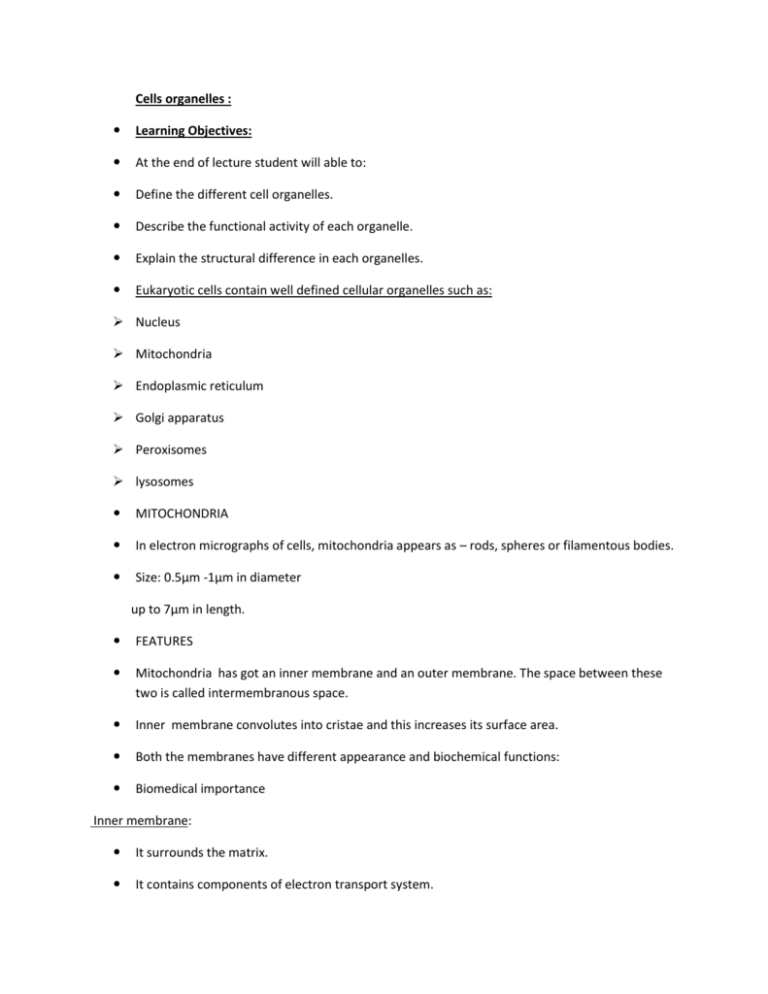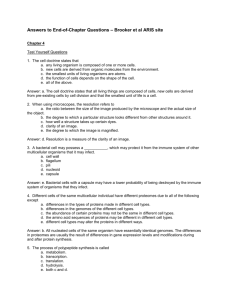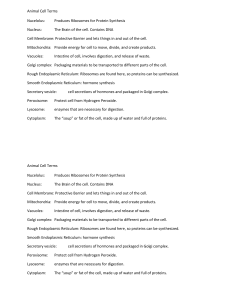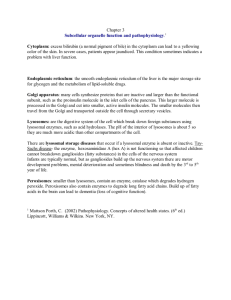Histology Cell Organelles By Dr. Nand Lal Dhomeja
advertisement

Cells organelles : Learning Objectives: At the end of lecture student will able to: Define the different cell organelles. Describe the functional activity of each organelle. Explain the structural difference in each organelles. Eukaryotic cells contain well defined cellular organelles such as: Nucleus Mitochondria Endoplasmic reticulum Golgi apparatus Peroxisomes lysosomes MITOCHONDRIA In electron micrographs of cells, mitochondria appears as – rods, spheres or filamentous bodies. Size: 0.5µm -1µm in diameter up to 7µm in length. FEATURES Mitochondria has got an inner membrane and an outer membrane. The space between these two is called intermembranous space. Inner membrane convolutes into cristae and this increases its surface area. Both the membranes have different appearance and biochemical functions: Biomedical importance Inner membrane: It surrounds the matrix. It contains components of electron transport system. It is impermeable to most ions including H, Na, ATP, GTP, CTP etc and to large molecules. For the transport special carriers are present e.g. adenine nucleotide carrier(ATP –ADP transport). Complex II i.e. Succinate dehydrogenase . Complex V i.e. ATP synthase complex. Outer membrane: It is permeable to most ions and molecules which can move from the cytosol to intermembranous space. Matrix: It is enclosed by the inner mitochondrial membrane. Contains enzymes of citric acid cycle. Enzymes of β-oxidation of fatty acids. Enzymes of amino acids oxidation. Some enzymes of urea and heme synthesis. NAD FAD ADP,Pi. Mitochondrial DNA. Mitochondrial cytochrome P450 system- it causes: a. Hydroxylation of cholesterol to steroid hormones (placenta, adrenal cortex, ovaries and testes) b. Bile acid synthesis (liver) c. Vitamin D formation( kidney). Mitochondria plays a key role in aging- Cytochrome c component of ETC plays a main role in cell death and apoptosis. Mitochondria have a role in its own replication- they contain copies of circular DNA called mitochondrial DNA, this DNA have information for 13 mitochondrial proteins and some RNAs. This is DNA inherited from mothers. Most mitochondrial proteins are derived from genes in nuclear DNA. Mutation rate in mt DNA is 10 times more. Mitochondrial Diseases: i. Fatal infantile mitochondrial myopathy and renal dysfunction ii. MELAS(mitochondrial encephalopathy, lactic acidosis and stroke). iii. Lebers hereditary optic neuropathy iv. Myoclonic epilepsy v. Ragged red fiber disease. Also implicated in: Alzheimer’s disease, Parkinson’s , Cardiomyopathies and diabetes. ENDOPLASMIC RETICULUM Cytoplasm of eukaryotic cells contain a network of interconnecting membranes. This extensive structure is called endoplasmic reticulum. It consists of membranes with smooth appearance in some areas and rough appearance in some areas- Smooth endoplasmic reticulum and rough endoplasmic reticulum. Biomedical importance Rough Endoplasmic Reticulum These membranes enclose a lumen. In this lumen newly synthesized proteins are modified. Rough appearance is due to the presence of ribosomes attached on its cytosolic side(outer side). These ribosomes are involved in the biosynthesis of proteins. These proteins are either incorporated into the membranes or into the organelles. Special proteins are present that are called CHAPERONES. Theses proteins play a role in proper folding of proteins. Protein glycosylation also occurs in ER i.e. the carbohydrates are attached to the newly synthesized proteins. Smooth Endoplasmic Reticulum Smooth endoplasmic reticulum is involved in lipid synthesis. Cholesterol synthesis Steroid hormones synthesis. Detoxification of endogenous and exogenous substances. The enzyme system involved in detoxification is called Microsomal Cytochrome P450 monooxygenase system(xenobiotic metabolism). ER along with Golgi apparatus is involved in the synthesis of other organelles –lysosomes & Peroxisomes. Elongation of fatty acids e.g. Palmitic acid 16 C- Stearic acid 18 C. Desaturation of fatty acids. Omega oxidation of fatty acids. GOLGI APPARATUS Golgi complex is a network of flattened smooth membranous sacs- cisternae and vesicles. These are responsible for the secretion of proteins from the cells(hormones, plasma proteins, and digestive enzymes). It works in combination with ER. Enzymes in golgi complex transfer carbohydrate units to proteins to form of glycoporoteins, this determines the ultimate destination of proteins. Golgi is the major site for the synthesis of new membrane, lysosomes and peroxisomes. It plays two major roles in the membrane synthesis: i. It is involved in the processing of oligosaccharide chains of the membranes (all parts of the GA participates). ii. It is involved in the sorting of various proteins prior to their delivery(Trans Golgi network). LYSOSOMES These are responsible for the intracellular digestion of both intra and extracellular substances. They have a single limiting membrane. They have an acidic pH- 5 They have a group of enzymes called Hydrolases. Biomedical importance The enzyme content varies in different tissues according to the requirement of tissues or the metabolic activity of the tissue. Lysosomal membrane is impermeable and specific translocators are required. Vesicles containing external material fuses with lysosomes, form primary vesicles and then secondary vesicles or digestive vacoules. Lysosomes are also involved in autophagy. Products of lysosomal digestion are released and reutilised. Indigestible material accumulates in the vesicles called residual bodies and their material is removed by exocytosis. Some residual bodies in non dividing cells contain a high amount of a pigmented substance called Lipofuscin. Also called age pigment or wear –tear pigment. In some genetic disease individual lysosomal enzymes are missing and this lead to the accumulation of that particular substance. Such lysosomes gets enlarged and they interfere the normal function of the cell. Such diseases are called lysosomal storage diseases Most impt is I-cell disease. PEROXISOMES Called Peroxisomes because of their ability to produce or utilize H2O2. They are small, oval or spherical in shape. They have a fine network of tubules in their matrix. About 50 enzymes have been identified. The number of enzymes fluctuates according to the function of the cells. Biomedical importance Xenobiotics leads to the proliferation of Peroxisomes in the liver. Have an important role in the breakdown of lipids, particularly long chain fatty acids. Synthesis of glycerolipids. Synthesis of glycerol ether lipids. Synthesis of isoprenoids. Synthesis of bile. Oxidation of D- amino acids. Oxidation of Uric acid to allantoin (animals) Oxidation of Hydroxy acids which leads to the formation of H2O2. Contain catalase enzyme, which causes the breakdown of H2O2 . Diseases associated: Most important disease is Zellweger Syndrome. There is absence of functional peroxisomes. This leads to the accumulation of long chain fatty acids in the brain, decreased formation of plasmalogens, and defects of bile acid formation.








